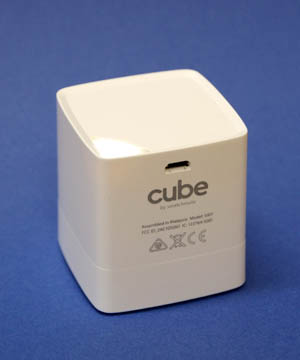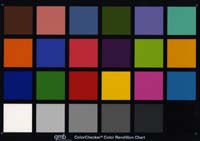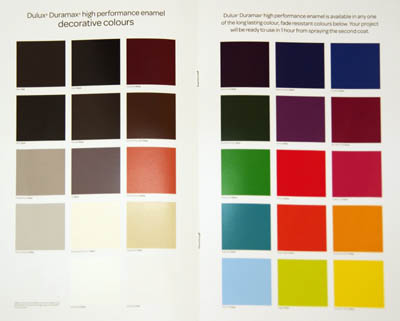Palette/SwatchMate
Cube, Part 1 - Out of the box accuracy.
Graeme W. Gill May, 2015.
I've had a few people ask me about the Palette/SwatchMate Cube :-
what I think about it, and whether I'm going to support it in ArgyllCMS or ColorMeter.
 Partly because it originates
in my own town of Melbourne Australia, and also to give some
perspective as to where these entry level devices fit into the
colour measurement landscape (see also the NODE Chroma
module and Nix Color Sensor
for roughly similar devices), I decided to buy one and take a closer
look at it.
Partly because it originates
in my own town of Melbourne Australia, and also to give some
perspective as to where these entry level devices fit into the
colour measurement landscape (see also the NODE Chroma
module and Nix Color Sensor
for roughly similar devices), I decided to buy one and take a closer
look at it.
For those not familiar with it, the Palette/SwatchMate Cube made a
splash about 18 months ago with a successful Kickstarter
crowd-funding campaign to build the first batch of units, and
followed up with an Indiegogo
campaign to build a second batch. As well as winning a 2013
Melbourne and Sydney Design Award, it garnered a great deal of
(sometimes rather breathless) press attention - you could almost be
forgiven for thinking that no-one had ever thought of measuring
colour before ! From the press and manufacturers information it
seems to be a measurement device aimed squarely at graphic artist
and interior designers, and looks particularly attractive due to its
relatively low cost and great convenience.
I'll make a few comments latter in the article, and go into even
more depth in Part 2, but for the moment
let's cut to the chase :- how accurate is it ?
Testing Method:
 Since this is a
Colorimeter rather than a Spectrometer, its accuracy could well be
dependent on the particular samples tested, so it's hard to be
entirely fair in choosing a test. So I decided to do a fairly
uncontroversial test :- benchmark it using the very well known
ColorChecker colours. These are 24 matt colours with both a range of
colour test patches as well as grey-scale, and having some diversity
of spectral composition (i.e. they are not created by a printing
process).
Since this is a
Colorimeter rather than a Spectrometer, its accuracy could well be
dependent on the particular samples tested, so it's hard to be
entirely fair in choosing a test. So I decided to do a fairly
uncontroversial test :- benchmark it using the very well known
ColorChecker colours. These are 24 matt colours with both a range of
colour test patches as well as grey-scale, and having some diversity
of spectral composition (i.e. they are not created by a printing
process).
 I also decided to see just how well or poorly it
copes with glossy colours, and chose a paint catalogue containing 28
glossy colours that use a classic 4 colour print process with a
glossy overcoat (Dulux dura max spray paint catalogue).
I also decided to see just how well or poorly it
copes with glossy colours, and chose a paint catalogue containing 28
glossy colours that use a classic 4 colour print process with a
glossy overcoat (Dulux dura max spray paint catalogue).
As a reference instrument, I used an X-Rite
eye-One Pro 2, a well respected graphic arts spectrometer. For
comparison, I also test an X-Rite
ColorMunki spectrometer, a cheaper spectral instrument. I
calculate the colour differences using two units, the well known
Delta E 1976 (which is simply the difference in the L*a*b*
perceptually uniform colourspace), and the more perceptually
accurate CIE Delta E 2000. 1 delta E corresponds to a "Just
Noticeable Difference" in colour. All measurements were for a
standard graphic arts conditions of D50 illuminant and a CIE 1931 2
degree observer.
As a guide, an error of 1 dE will be noticeable to a critical
observer under ideal viewing conditions.
3-4 may be sufficient for non-critical use, while 10+ will be easily
discernible to even a non-expert observer.
The DE76 values are for cross reference, the CIE DE2000 values are
what count in practice.
Matt measurements:
Palette/SwatchMate Cube
DE76:
worst = 17.9, average = 6.47
CIE DE2000: worst
= 10.5, average = 3.23
ColorMunki:
DE76:
worst = 1.77, average = 0.97
CIE DE2000: worst
= 1.35, average = 0.70
Gloss measurement:
Palette/SwatchMate Cube
DE76:
worst = 23.6, average = 12.1
CIE DE2000: worst
= 16.2, average = 8.18
ColorMunki:
DE76:
worst = 4.52, average = 1.86
CIE DE2000: worst =
3.96, average = 1.41
Conclusion:
Judging by the unit I purchased, the Palette/SwatchMate Cube
accuracy seems to be hit or miss. For some colours it seems to be
perfectly usable for non-critical purpose, but with other colours
(notably Reds, some Blues, and colours close to Black), it is not so
good. A 10 dE2000 error will be quite obvious.
The glossy measurements are spectacularly poor, indicating that it
is not suitable for glossy measurement as-is.
Alternatives - ColorMunki Design or Photo
The ColorMunki Design or Photo spectrometer is a much more versatile
instrument, capable of strip reading, display and lighting
measurement, and of spectral measures such as Colour Rendering
Index. As indicated in the above figures and error distribution
histogram, its accuracy puts it in a class above the
Palette/SwatchMate Cube (in fact the eye-one Pro 2 is probably not
quite accurate enough to use as a reference to benchmark it
against). It is nearly twice the cost though, but if accuracy is
important then you may be better off buying just a ColorMunki,
rather than a Cube and then a ColorMunki.
Palette/SwatchMate are to be congratulated on developing and
successfully launching an affordable colour measurement device, and
also in succeeding in raising the awareness of colour measurement
amongst the general public. It's therefore something of a
disappointment that the Cube doesn't have an accuracy proportionate
to its cost, and consequently there still seems to be room in the
market for a competitive low cost instrument, or perhaps for Palette
to update the Cube to addresses some of this first models
shortcomings.
Reflection: Colour Sensors are easy, instruments are hard:
Sensing the colour of light is cheap and easy - many low cost
industrial colour sensors or coloured LED's + a light sensor are
available. But emulating how humans see colour is harder - an
instrument has to be reasonably faithful in how it emulates the
human spectral sensitivities, including the large overlap between
the medium and long wavelength sensitive cones, as well as using an
appropriate measurement geometry :- when we want to asses a glossy
objects colour, we deliberately avoid looking where the specular
highlight is, since this gives us no information about its colour
composition. Consistently manufacturing a measurement device that
has an in-the-field performance equal to the prototypes, also has
its challenges.
In Part 2, I see if the
application of some Colour Science magic can at all improve the
accuracy of the Palette/SwatchMate Cube, as well as make it cope
with glossy surfaces somewhat more proficiently.
 Partly because it originates
in my own town of Melbourne Australia, and also to give some
perspective as to where these entry level devices fit into the
colour measurement landscape (see also the NODE Chroma
module and Nix Color Sensor
for roughly similar devices), I decided to buy one and take a closer
look at it.
Partly because it originates
in my own town of Melbourne Australia, and also to give some
perspective as to where these entry level devices fit into the
colour measurement landscape (see also the NODE Chroma
module and Nix Color Sensor
for roughly similar devices), I decided to buy one and take a closer
look at it. Since this is a
Colorimeter rather than a Spectrometer, its accuracy could well be
dependent on the particular samples tested, so it's hard to be
entirely fair in choosing a test. So I decided to do a fairly
uncontroversial test :- benchmark it using the very well known
ColorChecker colours. These are 24 matt colours with both a range of
colour test patches as well as grey-scale, and having some diversity
of spectral composition (i.e. they are not created by a printing
process).
Since this is a
Colorimeter rather than a Spectrometer, its accuracy could well be
dependent on the particular samples tested, so it's hard to be
entirely fair in choosing a test. So I decided to do a fairly
uncontroversial test :- benchmark it using the very well known
ColorChecker colours. These are 24 matt colours with both a range of
colour test patches as well as grey-scale, and having some diversity
of spectral composition (i.e. they are not created by a printing
process). I also decided to see just how well or poorly it
copes with glossy colours, and chose a paint catalogue containing 28
glossy colours that use a classic 4 colour print process with a
glossy overcoat (Dulux dura max spray paint catalogue).
I also decided to see just how well or poorly it
copes with glossy colours, and chose a paint catalogue containing 28
glossy colours that use a classic 4 colour print process with a
glossy overcoat (Dulux dura max spray paint catalogue).